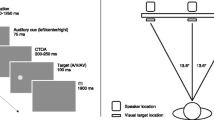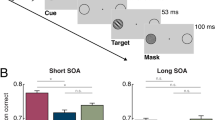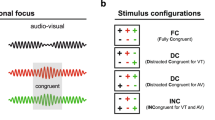Abstract
Previous studies have shown that the amplitude of event related brain potentials (ERPs) elicited by a combined audiovisual stimulus is larger than the sum of a single auditory and visual stimulus. This enlargement is thought to reflect multisensory integration. Based on these data, it may be hypothesized that the speeding up of responses, due to exogenous orienting effects induced by bimodal cues, exceeds the sum of single unimodal cues. Behavioral data, however, typically revealed no increased orienting effect following bimodal as compared to unimodal cues, which could be due to a failure of multisensory integration of the cues. To examine this possibility, we computed ERPs elicited by both bimodal (audiovisual) and unimodal (either auditory or visual) cues, and determined their exogenous orienting effects on responses to a to-be-discriminated visual target. Interestingly, the posterior P1 component elicited by bimodal cues was larger than the sum of the P1 components elicited by a single auditory and visual cue (i.e., a superadditive effect), but no enhanced orienting effect was found on response speed. The latter result suggests that multisensory integration elicited by our bimodal cues plays no special role for spatial orienting, at least in the present setting.






Similar content being viewed by others
Notes
Given the fact that the signal to noise ratio (SNR) of amplitude measures depends on the number of trials used to create the averages, we examined whether conditions differed in these amounts. A two-way ANOVA with the within-participants factors of Cue type (unimodal, crossmodal, or bimodal) and Cue Side (left or right) revealed no significant effects (all Fs < 2.7; Ps > 0.128), indicating that there were no differences in the number of trials between conditions.
References
Beauchamp MS, Argall BD, Bodurka J, Duyn JH, Martin A (2004) Unraveling multisensory integration: Patchy organization within human STS multisensory cortex. Nat Neurosci 7:1190–1192
Berger A, Henik A, Rafal R (2005) Competition between endogenous and exogenous orienting of visual attention. J Exp Psychol Gen 134:207–221
Bertelson P, Vroomen J, De Gelder B, Driver J (2000) The ventriloquist effect does not depend on the direction of deliberate visual attention. Percept Psychophys 62:321–332
Calvert GA, Campbell R, Brammer MJ (2000) Evidence from functional magnetic resonance imaging of crossmodal binding in the human heteromodal cortex. Curr Biol 10:649–657
Dhamala M, Assisi CG, Jirsa VK, Steinberg FL, Kelso JAS (2007) Multisensory integration for timing engages different brain networks. Neuroimage 34:764–773
Folk CL, Remington RW, Johnson JC (1992) Involuntary covert orienting is contingent on attentional control settings. J Exp Psychol Hum Percept 18:1030–1044
Fort A, Delpuech C, Pernier J, Giard MH (2002) Early auditory-visual interactions in human cortex during nonreduntant target identification. Cogn Brain Res 14:20–30
Funes MJ, Lupianez J, Milliken B (2005) The role of spatial attention and other processes on the magnitude and time course of cueing effects. Cogn Process 6:98–116
Giard MH, Perronet F (1999) Auditory-visual integration during multimodal object recognition in humans: a behavioral and electrophysiological study. J Cogn Neurosci 11:473–490
Hillyard SA (1973) The CNV and human behaviour. In: McCallum WC, Knott JR (eds) Event-related slow potentials of the brain: their relation to behaviour. Elsevier, Amsterdam, pp 161–171
Low KA, Miller J (1999) The usefulness of partial information: effects of go probability in the choice/Nogo task. Psychophysiology 36:288–297
McDonald JJ, Teder-Salejarvi WA, Ward LM (2001) Multisensory integration and crossmodal attention effects in the human brain. Science 292:1791
Molholm S, Ritter W, Murray MM, Javitt DC, Schroeder CE, Foxe JJ (2002) Multisensory auditory-visual interactions during early sensory processing in humans: a high-density electrical mapping study. Cogn Brain Res 14:115–128
Santangelo V, Ho C, Spence C (2007a) Capturing spatial attention with multisensory cues. Psychon Bull Rev (in press)
Santangelo V, Olivetti Belardinelli M, Spence C (2007b) The suppression of reflexive visual and auditory orienting when attention is otherwise engaged. J Exp Psychol Hum Percept 33:137–148
Santangelo V, Spence C (2007a) Multisensory cues capture spatial attention regardless of perceptual load. J Exp Psychol Hum Percept (in press)
Santangelo V, Spence C (2007b) Assessing the automaticity of the exogenous orienting of tactile attention. Perception (in press)
Santangelo V, Van der Lubbe RHJ, Olivetti Belardinelli M, Postma A (2006) Spatial attention triggered by unimodal, crossmodal, and bimodal exogenous cues: a comparison on reflexive orienting mechanisms. Exp Brain Res 173:40–48
Schwartz S, Vuilleumier P, Hutton C, Maravita A, Dolan RJ, Driver J (2005) Attentional load and sensory competition in human vision: modulation of fMRI responses by load at fixation during task-irrelevant stimulation in the peripheral visual field. Cereb Cortex 15:770–786
Senkowski D, Talsma D, Herrmann CS, Woldorff MG (2005) Multisensory processing and oscillatory gamma responses: effects of spatial selective attention. Exp Brain Res 166:411–426
Spence C, Driver J (1994) Covert spatial orienting in audition: exogenous and endogenous mechanisms. J Exp Psychol Human Percept 20:555–574
Spence C, Driver J (1999) A new approach to the design of multimodal warning signals. In: Harris D (ed) Engineering psychology and cognitive ergonomics. vol IV. Ashgate Publishing, Aldershot, pp 455–461
Stanford TR, Stein BE (2007) Superadditivity in multisensory integration: putting the computation in context. NeuroReport 18:787–792
Stein BE, Meredith MA (1993) The merging of the senses. MIT, Cambridge
Stein BE, Meredith MA, Wallace MT (1993) The visually responsive neuron and beyond: multisensory integration in cat and monkey. Prog Brain Res 95:79–90
Talsma D, Woldorff MG (2005) Selective attention and multisensory integration: multiple phases of effects on the evoked brain activity. J Cogn Neurosci 17:1098–1114
Teder-Sälejärvi WA, McDonald JJ, Di Russo F, Hillyard SA (2002) An analysis of audio–visual crossmodal integration by means of event-related potential (ERP) recordings. Cogn Brain Res 14:106–114
Van der Lubbe RHJ, Havik MM, Bekker EM, Postma A (2006) Task-dependent exogenous cuing effects depend on cue modality. Psychophysiol 43:145–160
Van der Lubbe RHJ, Postma A (2005) Interruption from irrelevant auditory and visual onsets even when attention is in a focused state. Exp Brain Res 164:464–471
Van der Lubbe RHJ, Van der Helden J (2006) Failure of the extended contingent attentional capture account in multimodal settings. Adv Cogn Psychol 2:255–267
Vroomen J, Bertelson P, De Gelder B (2001) The ventriloquist effect does not depend on the direction of automatic visual attention. Percept Psychophys 63:651–659
Wallace MT, Meredith MA, Stein BE (1998) Multisensory integration in the superior colliculus of the alert cat. J Neurophysiol 80:1006–1010
Ward LM (1994) Supramodal and modality-specific mechanisms for stimulus-driven shifts of auditory and visual attention. Can J Exp Psychol 48:242–259
Ward LM, McDonald JJ, Golestani N (1998) Cross-modal control of attention shifts. In: Wright RD (eds) Visual attention. Oxford University Press, New York, pp 232–268
Acknowledgments
This study was supported by a grant from the Netherlands Organization for Scientific Research to Albert Postma (NWO, No. 440–20–000).
Author information
Authors and Affiliations
Corresponding author
Rights and permissions
About this article
Cite this article
Santangelo, V., Van der Lubbe, R.H.J., Olivetti Belardinelli, M. et al. Multisensory integration affects ERP components elicited by exogenous cues. Exp Brain Res 185, 269–277 (2008). https://doi.org/10.1007/s00221-007-1151-5
Received:
Accepted:
Published:
Issue Date:
DOI: https://doi.org/10.1007/s00221-007-1151-5




